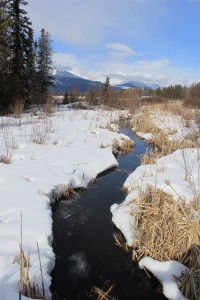
By: Korie Marshall
About 15 residents, including representatives from both VARDA and YORA, showed up at the open house about a management plan for the Cranberry Marsh/Starratt Wildlife Management Area.
Duncan McColl, Environmental Biologist with the Ministry of FLNRO, was there to discuss options, and get public feedback about whether or not motorized vehicles, horses, camping, campfires, etc should be allowed in the sanctuary.
McColl says the Cranberry Marsh has been a sanctuary since 1972; the property was donated with wildlife conservation in mind, and ministry is bound by that, as well as the recent Wildlife Management Area designation for the 319 hectares of Crown land, Nature Trust of BC land, and privately donated land that makes up the Starratt Wildlife Sanctuary. He wants to know what residents use the property for now, but notes that conservation of the wildlife habitat is the primary concern for the property.
The designation of a Wildlife Management Area is done under the province’s Wildlife Act, under the authority of the Ministry of Forests, Lands and Natural Resource Operations with the approval of Cabinet, but other compatible land uses may be accommodated. The Ministry’s Regional Manager can establish orders that prohibit or restrict certain activities in a WMA that impact wildlife or habitat. A management plan, developed in consultation with partners, First Nations, agencies, stakeholders and the public is used to help guide activities in a WMA.
The question that received the most floor time was whether to allow or restrict motorized vehicles such as ATV’s, sleds and motor bikes. Some residents say the marsh is no place for motorized vehicles, that they should never have been allowed in a sanctuary, while others say there needs to be a corridor or a trail to allow vehicles to get out of the Village limits and to wherever they are going.
McColl says there are two issues with allowing a corridor, for example, along the dyke through the marsh. First, if you allow something in one section, you cannot legally prohibit it in another section of the WMA. Second, it would be similar to entrapment, since you are not legally allowed to ride motorized vehicles at either end of the corridor.
Residents discussed how new ORV regulations might affect that, and ideas of working with other partners to allow trails or routes for motorized off-road vehicles, but McColl notes that everything outside of the boundary of the 319 hectares is outside of his jurisdiction.
Resident’s also had concerns about disturbing birds during nesting season; the need for more signage and interpretive information; maintenance of bridges and viewing towers through the marsh; and dealing with invasive plants like thistle and cattail. McColl says the cattail is under control by a healthy population of muskrats, which eat the cattail in certain areas. He says the North West Invasive Plant Council will be working on the thistle for the next 5 years, as that is how long it will take to get it under control.
McColl says the presence of a protected bird that is very sensitive to noise is another reason to exclude motorized vehicles from the WMA.
Maintenance of signs, bridges and viewing towers are now the responsibility of the ministry, and McColl says he’s been working to repair the bridges this fall. The viewing towers will be regularly inspected, and signs on order now to be replaced, staying with the flavour and character of current signage throughout the marsh.
The management plan could also restrict things like camping, camp fires, and horses.
The meeting held Nov. 6th at the Bears Den at the Best Western. Some attendees said the meeting should have been better advertised, and that more of the public should be allowed to discuss the management plan before it is finalized. A date for the release of the finalized plan has not yet been set.



